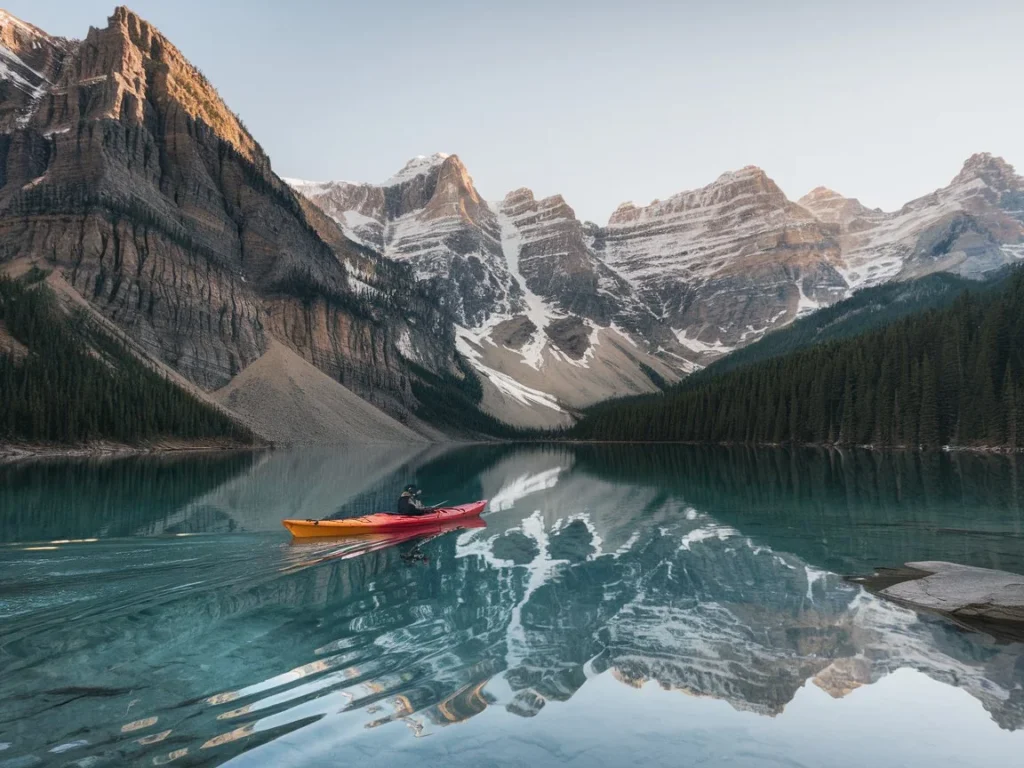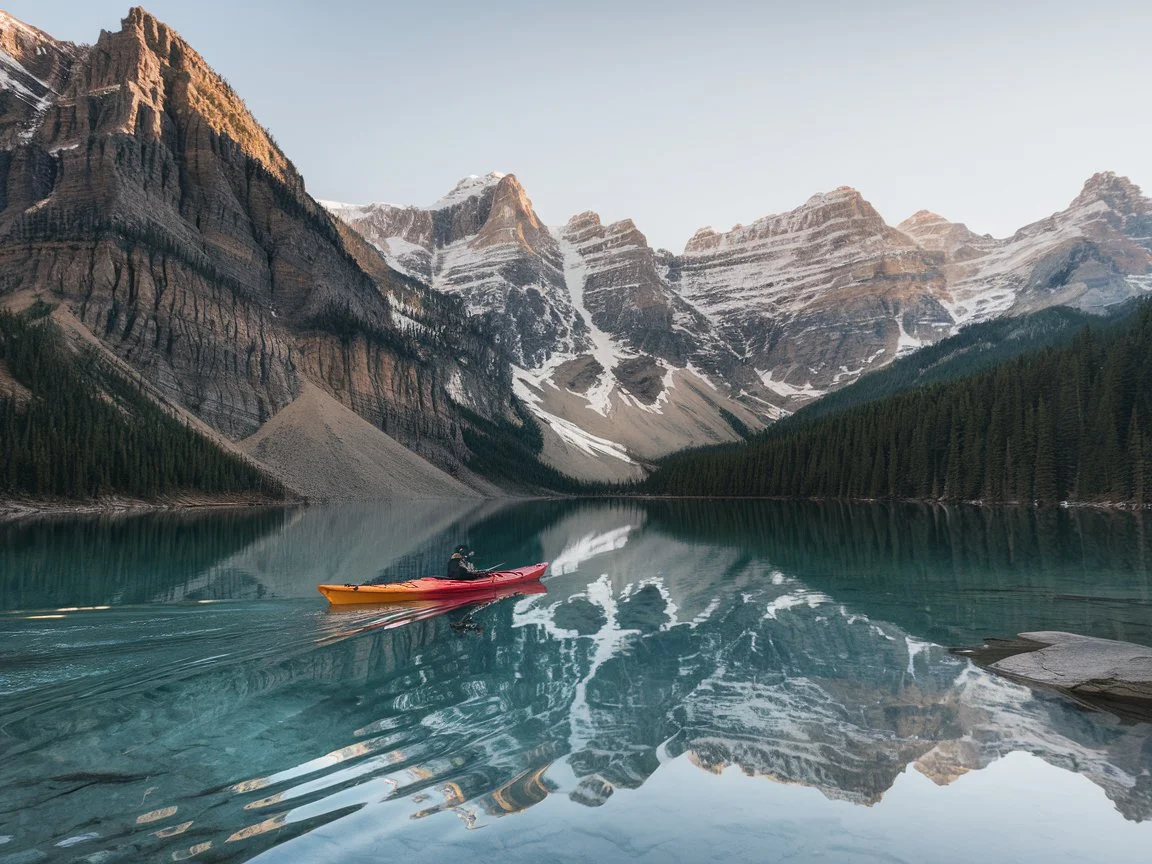
Introduction
Kayaking and canoeing in mountain lakes and rivers offer a unique way to experience the beauty of the wilderness. Gliding across crystal-clear waters, surrounded by towering peaks and lush forests, is an unforgettable adventure. Whether you’re paddling through the calm, reflective surface of a mountain lake or navigating the gentle currents of a winding river, these activities provide a perfect blend of tranquility and excitement.
While kayaking and canoeing share similarities, they cater to different preferences and water conditions. Kayaks are sleek and nimble, ideal for solo paddlers or those seeking speed and maneuverability. Canoes, on the other hand, are stable and spacious, making them great for group trips or carrying gear. This guide will take you through the best locations, essential gear, safety tips, and techniques to help you make the most of your paddling adventure. So grab your paddle, embrace the serenity of the water, and let the mountains guide your journey.
1. Best Mountain Lakes and Rivers for Paddling
Mountain lakes and rivers offer some of the most scenic and rewarding paddling experiences. Here are three must-visit destinations:
- Lakes:
- Description: Mountain lakes are known for their calm waters, stunning reflections, and serene atmosphere. They’re perfect for beginners or those looking for a peaceful paddle.
- Example: Lake Louise in Banff National Park, Canada, is a turquoise gem surrounded by snow-capped peaks and lush forests.
- Rivers:
- Description: Mountain rivers range from gentle streams to thrilling whitewater rapids, offering something for every skill level.
- Example: The Snake River in Grand Teton National Park, Wyoming, offers calm sections with breathtaking views of the Teton Range.
- Top Locations:
- Location 1: Lake Tahoe, California/Nevada – Known for its clear blue waters and scenic shoreline.
- Location 2: Green River, Utah – Offers calm sections and stunning red rock canyons.
- Location 3: Bowron Lakes, British Columbia – A chain of lakes perfect for multi-day canoe trips.
2. Essential Gear for Mountain Kayaking and Canoeing
Having the right gear ensures a safe and enjoyable paddling experience.
- Choosing the Right Boat:
- Kayaks: Ideal for solo paddlers or those seeking speed and agility. Choose between sit-on-top or sit-inside models.
- Canoes: Great for group trips or carrying gear. They’re stable and spacious, making them perfect for family outings.
- Paddles & Safety Equipment:
- Paddles: Choose a paddle that’s the right length and weight for your boat and body size.
- Life Jackets: A properly fitted life jacket is essential for safety.
- Dry Bags: Keep your gear dry with waterproof bags.
- Clothing & Accessories:
- Wetsuits or Drysuits: For cold water or weather conditions.
- Sunscreen & Sunglasses: Protect yourself from the sun’s glare on the water.
- Water Shoes: Provide traction and protection on slippery surfaces.
3. Understanding Water Conditions and Safety
Being aware of water conditions and safety measures is crucial for a successful paddling trip.
- Calm vs. Rapid Waters:
- Calm Waters: Lakes and slow-moving rivers are ideal for beginners.
- Rapid Waters: Whitewater rivers require advanced skills and proper safety gear.
- Weather Awareness:
- Check the forecast before heading out. Wind, temperature, and storms can impact your paddling experience.
- Safety Tips:
- Capsizing: Learn how to re-enter your boat or swim to shore safely.
- Obstacles: Avoid rocks, logs, and other hazards in the water.
- Emergency Preparedness: Carry a whistle, first-aid kit, and communication device.
4. Techniques for an Enjoyable Paddling Experience
Mastering basic techniques will enhance your paddling experience.
- Basic Paddling Strokes:
- Forward Stroke: The most efficient way to move forward.
- Sweep Stroke: Used for turning the boat.
- Draw Stroke: Helps move the boat sideways.
- Navigating Different Waterways:
- Calm Lakes: Focus on smooth, steady strokes.
- Flowing Rivers: Use the current to your advantage and steer around obstacles.
- Solo vs. Group Paddling:
- Solo: Offers independence and a personal connection with nature.
- Group: Provides camaraderie and shared experiences.
5. Wildlife and Scenic Views from the Water
Paddling offers a unique perspective on wildlife and scenery.
- Animals You Might Encounter:
- Birds: Eagles, herons, and ospreys are often seen near the water.
- Fish: Trout and salmon are common in mountain lakes and rivers.
- Mammals: Beavers, otters, and deer can be spotted along the shoreline.
- Best Times for Scenic Views:
- Sunrise and Sunset: The golden light creates stunning reflections on the water.
- Photography Tips:
- Use a waterproof camera or phone case to capture the beauty of the landscape.
6. Planning a Multi-Day Canoe or Kayak Trip
A multi-day paddling trip requires careful planning and preparation.
- Packing Essentials:
- Bring lightweight, compact gear, including a tent, sleeping bag, and cooking supplies.
- Camping on the Shoreline:
- Choose designated campsites or follow Leave No Trace principles when setting up camp.
- Combining Activities:
- Add fishing, hiking, or photography to your paddling adventure for a well-rounded experience.
Conclusion
Kayaking and canoeing in mountain lakes and rivers offer a unique way to explore the wilderness and connect with nature. Whether you’re gliding across a serene lake or navigating a flowing river, the experience is both peaceful and exhilarating. By choosing the right gear, practicing safety measures, and respecting the environment, you can make the most of your paddling adventure. So grab your paddle, embrace the beauty of the mountains, and let the water guide your journey. Remember, the mountains are calling—will you answer?
Explore more at Cabin Mountains – Mountain Cabin Essentials: The Ultimate Guide

